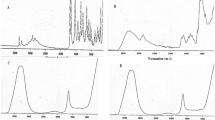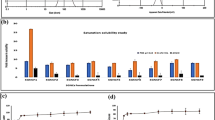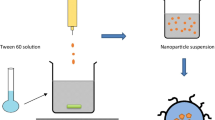Abstract
The present work embarks upon increasing the dissolution rate and the bioavailability of model anti-diabetic drug, gliquidone, a sulfonylurea class drug used for treating diabetes mellitus type 2. The gliquidone nanoparticles were prepared by using anti-solvent precipitation technique in which, gliquidone solution in acetone was added at a controlled rate to an aqueous solution containing polyvinylpyrrolidone K25 (PVP K25) as stabilizer. The effect of drug concentration (X1), polymer concentration (X2) and solvent to anti-solvent ratio (X3) on particle size and dissolution was studied using Box-Behnken design. The results revealed that by decreasing the drug concentration and by increasing the stabilizer concentration and solvent/anti-solvent ratio, reduction in the size of the particles was observed. The mentioned parameters were optimised and particle of size about 175 nm was achieved. The relative dissolution rate of prepared gliquidone nanoparticles in phosphate buffer pH 7.4 was ~ 4.7 times faster than original drug at t = 45 min. Further, the gliquidone nanoparticles were characterized by scanning electron microscope (SEM), Fourier transform-infrared spectroscopy (FTIR), differential scanning calorimetry (DSC) and X-ray powder diffraction (XRD). The particles revealed to be oval in shape with stabilizer molecules on surface and exhibited decreased crystalline nature when compared to free gliquidone. Finally, the in vivo studies using gliquidone nanoparticles revealed ~ 2.5-fold increase in Cmax when taken orally in the form of hard gelatin capsules in comparison to free gliquidone. Thus, overall investigation suggests that the developed strategy of gliquidone nanoparticles possess a keen potential for exhibiting anti-diabetic effect.











Similar content being viewed by others
References
Arnouts P, Bolignano D, Nistor I, Bilo H, Gnudi L, Heaf J, et al. Glucose-lowering drugs in patients with chronic kidney disease: a narrative review on pharmacokinetic properties. Nephrology Dialysis Transplantation. 2013;29(7):1284–300.
Tripathi K. Essentials of medical pharmacology: JP Medical Ltd; 2013.
Miro A, Quaglia F, Sorrentino U, La Rotonda M, Bianca REDV, Sorrentino R. Improvement of gliquidone hypoglycaemic effect in rats by cyclodextrin formulations. Eur J Pharm Sci. 2004;23(1):57–64.
Savjani KT, Gajjar AK, Savjani JK. Drug solubility: importance and enhancement techniques. ISRN pharmaceutics. 2012;2012.
Khames A. Investigation of the effect of solubility increase at the main absorption site on bioavailability of BCS class II drug (risperidone) using liquisolid technique. Drug delivery. 2017;24(1):328–38.
Martnez P, Goñi M, Cantera R, Martin C, Dios-Viéitez C, Martínez-Ohárriz C. Preparation and dissolution rate of gliquidone-PVP K30 solid dispersions. Eur J Drug Metab Pharmacokinet. 1998;23(2):113–7.
Sridevi S, Chauhan A, Chalasani K, Jain A, Diwan P. Enhancement of dissolution and oral bioavailability of gliquidone with hydroxy propyl-β-cyclodextrin. Die Pharmazie-An International Journal of Pharmaceutical Sciences. 2003;58(11):807–10.
Patravale V, Date AA, Kulkarni R. Nanosuspensions: a promising drug delivery strategy. J Pharm Pharmacol. 2004;56(7):827–40.
Merisko-Liversidge EM, Liversidge GG. Drug nanoparticles: formulating poorly water-soluble compounds. Toxicol Pathol. 2008;36(1):43–8.
Sun J, Wang F, Sui Y, She Z, Zhai W, Wang C, et al. Effect of particle size on solubility, dissolution rate, and oral bioavailability: evaluation using coenzyme Q10 as naked nanocrystals. Int J Nanomedicine. 2012;7:5733.
Kesisoglou F, Panmai S, Wu Y. Nanosizing—oral formulation development and biopharmaceutical evaluation. Adv Drug Deliv Rev. 2007;59(7):631–44.
Khadka P, Ro J, Kim H, Kim I, Kim JT, Kim H, et al. Pharmaceutical particle technologies: an approach to improve drug solubility, dissolution and bioavailability. Asian Journal of Pharmaceutical Sciences. 2014;9(6):304–16.
Merisko-Liversidge E, Liversidge GG, Cooper ER. Nanosizing: a formulation approach for poorly-water-soluble compounds. Eur J Pharm Sci. 2003;18(2):113–20.
Fakes MG, Vakkalagadda BJ, Qian F, Desikan S, Gandhi RB, Lai C, et al. Enhancement of oral bioavailability of an HIV-attachment inhibitor by nanosizing and amorphous formulation approaches. Int J Pharm. 2009;370(1–2):167–74.
Vimalson DC. Techniques to enhance solubility of hydrophobic drugs: an overview. Asian Journal of Pharmaceutics (AJP): Free full text articles from Asian J Pharm. 2016;10(2).
Yadav M, Dhole S, Chavan P. Nanosuspension: a novel techniques in drug delivery system. World Journal of Pharmacy and Pharmaceutical Sciences. 2014;3(2):410–33.
Krishna KB, Prabhakar C. A review on nanosuspensions in drug delivery. Int J Pharma and Bio Sci. 2011;2(1):549–58.
Li M, Azad M, Davé R, Bilgili E. Nanomilling of drugs for bioavailability enhancement: a holistic formulation-process perspective. Pharmaceutics. 2016;8(2):17.
Keck CM, Müller RH. Drug nanocrystals of poorly soluble drugs produced by high pressure homogenisation. Eur J Pharm Biopharm. 2006;62(1):3–16.
Matteucci ME, Hotze MA, Johnston KP, Williams RO. Drug nanoparticles by antisolvent precipitation: mixing energy versus surfactant stabilization. Langmuir. 2006;22(21):8951–9.
Dong Y, Ng WK, Shen S, Kim S, Tan RB. Preparation and characterization of spironolactone nanoparticles by antisolvent precipitation. Int J Pharm. 2009;375(1–2):84–8.
Reverchon E, De Marco I, Torino E. Nanoparticles production by supercritical antisolvent precipitation: a general interpretation. J Supercrit Fluids. 2007;43(1):126–38.
Thorat AA, Dalvi SV. Liquid antisolvent precipitation and stabilization of nanoparticles of poorly water soluble drugs in aqueous suspensions: recent developments and future perspective. Chem Eng J. 2012;181:1–34.
Kakran M, Sahoo G, Li L. Fabrication of nanoparticles of silymarin, hesperetin and glibenclamide by evaporative precipitation of nanosuspension for fast dissolution. Pharm Anal Acta. 2015;6(326):2.
Afifi SA, Hassan MA, Abdelhameed AS, Elkhodairy KA. Nanosuspension: an emerging trend for bioavailability enhancement of etodolac. International Journal of Polymer Science. 2015;2015.
Xu Y, Liu X, Lian R, Zheng S, Yin Z, Lu Y, et al. Enhanced dissolution and oral bioavailability of aripiprazole nanosuspensions prepared by nanoprecipitation/homogenization based on acid–base neutralization. Int J Pharm. 2012;438(1–2):287–95.
Kakran M, Sahoo NG, Li L, Judeh Z. Fabrication of quercetin nanoparticles by anti-solvent precipitation method for enhanced dissolution. Powder Technol. 2012;223:59–64.
El-Feky GS, Zayed G, Farrag A. Optimization of an ocular nanosuspension formulation for acyclovir using factorial design. Int J Pharm Pharm Sci. 2013;5:213–9.
Costa P, Lobo JMS. Modeling and comparison of dissolution profiles. Eur J Pharm Sci. 2001;13(2):123–33.
Zayed G. Dissolution rate enhancement of Ketoprofen by surface solid dispersion with colloidal silicon dioxide. Unique Journal of Pharmaceutical and Biological Sciences. 2014;1:33–8.
Kakran M, Sahoo N, Li L, Judeh Z, Wang Y, Chong K, et al. Fabrication of drug nanoparticles by evaporative precipitation of nanosuspension. Int J Pharm. 2010;383(1–2):285–92.
Giri TK. Manjusha (2013). Comparative in-vitro evaluation of conventional ibuprofen marketed formulation. J Pharm Sci Technol2(2):75–80.
Helmy SA, El Bedaiwy HM. In vitro dissolution similarity as a surrogate for in vivo bioavailability and therapeutic equivalence. Dissolution Technologies. 2016;8:32–9.
Sridevi S, DIWAN PV. Validated HPLC method for the determination of gliquidone in rat plasma. Pharm Pharmacol Commun. 2000;6(7):303–7.
Zhang J, Brent Miller R, Russell S, Jacobus R. Validation of a stability-indicating HPLC method for the determination of dipyridamole in dipyridamole injection. J Liq Chromatogr Relat Technol. 1997;20(13):2109–21.
Guozhong C. Nanostructures and nanomaterials: synthesis, properties and applications: world scientific; 2004.
Pharmacopoeia B, Volume I. II-III. Cambridge, London: University Press; 2009.
Yeole B, Patil R, Lone K, Tekade A. Preparation of nanoparticles of poorly water soluble dronedarone by antisolvent addition technique using natural polymer as a stabilizer. Journal of Pharmaceutical Research and Clinical Practice. 2016;6(4):8.
Dalvi SV, Dave RN. Controlling particle size of a poorly water-soluble drug using ultrasound and stabilizers in antisolvent precipitation. Ind Eng Chem Res. 2009;48(16):7581–93.
Wang Y, Zheng Y, Zhang L, Wang Q, Zhang D. Stability of nanosuspensions in drug delivery. J Control Release. 2013;172(3):1126–41.
Du B, Shen G, Wang D, Pang L, Chen Z, Liu Z. Development and characterization of glimepiride nanocrystal formulation and evaluation of its pharmacokinetic in rats. Drug delivery. 2013;20(1):25–33.
Kakran M, Sahoo NG, Li L, Judeh Z. Particle size reduction of poorly water soluble artemisinin via antisolvent precipitation with a syringe pump. Powder Technol. 2013;237:468–76.
Nada A. Formulation of ibuprofen nanoparticles and nanosuspensions with enhanced dissolution rate using ultra-homogenization technique. Asian Journal of Pharmaceutics (AJP): Free full text articles from Asian J Pharm. 2017;11(01).
Kim S, Lee J. Effective polymeric dispersants for vacuum, convection and freeze drying of drug nanosuspensions. Int J Pharm. 2010;397(1–2):218–24.
Lonare AA, Patel SR. Antisolvent crystallization of poorly water soluble drugs. International Journal of Chemical Engineering and Applications. 2013;4(5):337.
Wang Z, Chen J-F, Le Y, Shen Z-G, Yun J. Preparation of ultrafine beclomethasone dipropionate drug powder by antisolvent precipitation. Ind Eng Chem Res. 2007;46(14):4839–45.
Patel DD, Anderson BD. Adsorption of polyvinylpyrrolidone and its impact on maintenance of aqueous supersaturation of indomethacin via crystal growth inhibition. J Pharm Sci. 2015;104(9):2923–33.
Shah SR, Parikh RH, Chavda JR, Sheth NR. Glibenclamide nanocrystals for bioavailability enhancement: formulation design, process optimization, and pharmacodynamic evaluation. J Pharm Innov. 2014;9(3):227–37.
Hintz RJ, Johnson KC. The effect of particle size distribution on dissolution rate and oral absorption. Int J Pharm. 1989;51(1):9–17.
Radtke M. Pure drug nanoparticles for the formulation of poorly soluble drugs. New Drugs. 2001;3(62–68).
Acknowledgments
The authors are grateful to Faculty of Pharmacy, Al Azhar University, Assiut for providing the facilities. The authors are also thankful to Mianpharm pharmaceuticals, Egypt for supplying gliquidone and Chemical Industries Development, Egypt for providing capsules.
Author information
Authors and Affiliations
Corresponding author
Additional information
Publisher’s Note
Springer Nature remains neutral with regard to jurisdictional claims in published maps and institutional affiliations.
Rights and permissions
About this article
Cite this article
Mohamed, M.S., Abdelhafez, W.A., Zayed, G. et al. Optimization, in-vitro Release and in-vivo Evaluation of Gliquidone Nanoparticles. AAPS PharmSciTech 21, 35 (2020). https://doi.org/10.1208/s12249-019-1577-7
Received:
Accepted:
Published:
DOI: https://doi.org/10.1208/s12249-019-1577-7




